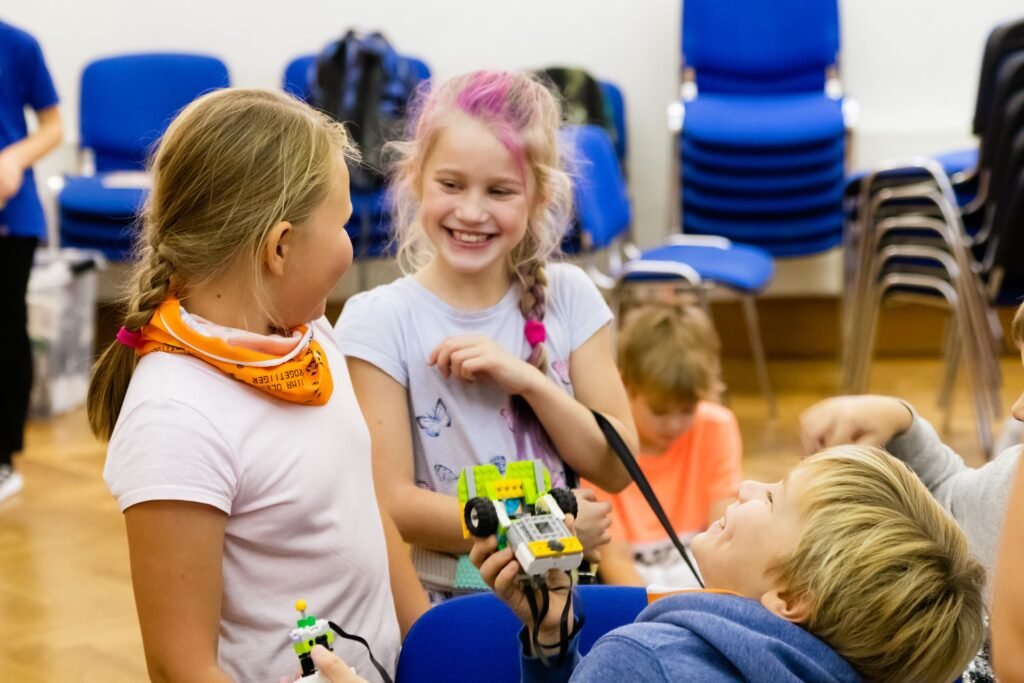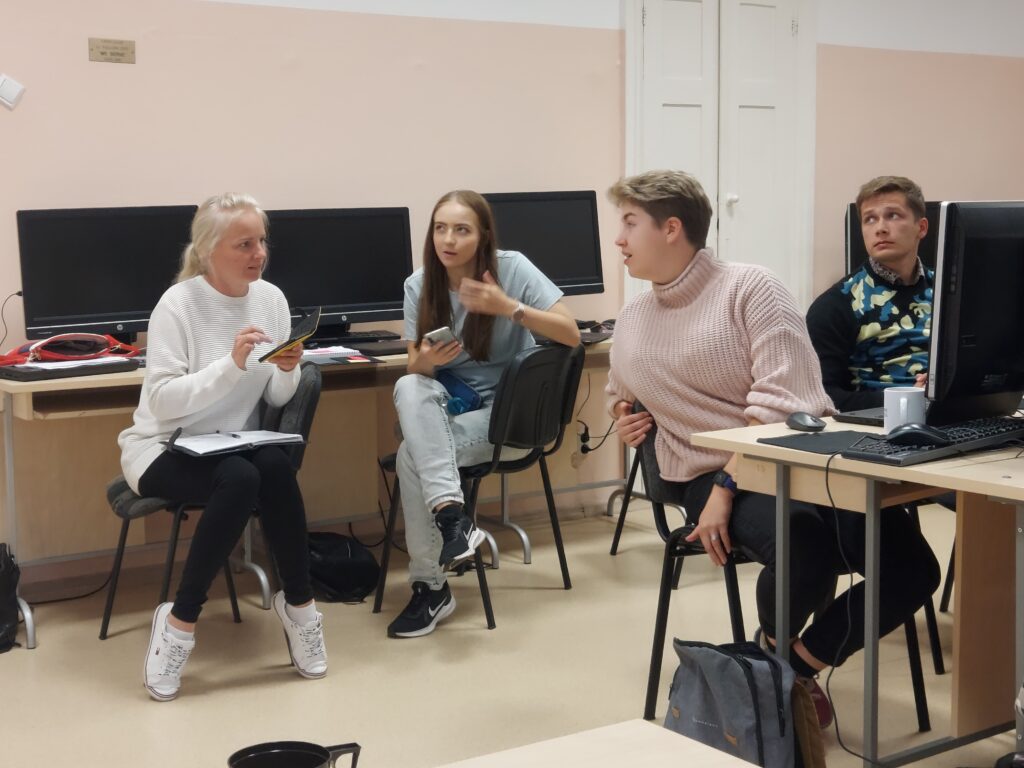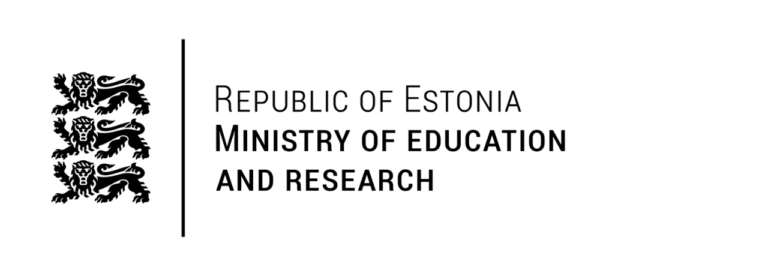Estonians are taking care that our own Steve Jobs and / or Elon Musk could learn tomorrow’s skills already from early childhood. More than half of schools and a number of kindergartens in Estonia teach children programming and robotics through play, so that they would – without too much effort or screen time – pick up IT skills.
The article by Ronald Liive was first published on the Invest in Estonia webpage.
Birgit Lao, Estonian Ambassador-at-large for Education, confirms that this is really happening and not just hype. The only bit you should take with a grain of salt is that Estonia’s direct objective is not to mass-produce tech tycoons like Jobs and Musk. A future world-famous electronic music composer from Estonia would be a very cool achievement, for example. Lao’s and many other Estonians’ regular work is to guarantee, via the four so-called secret components, a digitally competent and technologically savvy workforce for every field.
Children are given robots as early as kindergarten
Access to the Internet is considered a human right in Estonia. However, creating a digitally competent and technologically savvy new generation in Estonia has been a decades-long effort. It began in the 1990s, when every Estonian school was fitted with computers and Internet access. By the year 2000, Internet access was available to all the schools in Estonia. IT education received an even bigger boost with the ProgeTiger programme, which guaranteed every Estonian student from kindergarten to vocational school access to high-quality IT education.
“ProgeTiger ensures that teachers are competent and appropriate curriculum materials are readily available,” explains Kirke Kasari, Programme Manager of ProgeTiger. It is a wide programme where, in addition to training and events, an online environment plays a major role in providing teachers, students and parents free materials on how to teach students programming through play, using Blue-Bot, LEGO, Dash and Dot or other robots.
Thus, children can be taught many valuable activities and skills for life using robots, without them having to sit behind a computer screen.
“ProgeTiger has been a success over the past decade,” Kasari says. “The majority of educational institutions in Estonia have been involved with the programme in some kind of capacity, whether they have undergone training, received grants to purchase equipment or taken part in events and seminars.”
Kasari states that the feedback from kindergartens and schools has been highly positive, and people from around the world are always asking about the remarkable things the Estonians are doing in their education system. The project manager says they are always getting questions from the United States of America, South Korea and elsewhere on whether what they hear in the media about Estonia is correct.
The first students who grew up with ProgeTiger are graduating secondary school in a few years, which will allow us to gain a statistical overview of the number of students who have encountered robotics since kindergarten and go on to study IT in universities. Kasari also highlights that those numbers may not be of the upmost importance, because the overall objective of the programme is to provide digital competence and technological savviness to all, no matter what their future career paths.
ProgeTiger is not just a resource for free educational material. It also provides financial support to educational institutions, both for purchasing robots and sharing experiences.
“The ProgeTiger programme is a fantastic example of how to promote tech education at the national level,” Kasari notes. “People should definitely contact us if they are interested in the topic, as we are ready to share our Estonian experience.”
Digital is everywhere
A new position for Estonian civil servants was created last year – Ambassador-at-large for Education. Birgit Lao currently holds this position, and her objective is to introduce the approaches and practices used in Estonia that have brought the country success over the past few decades to the rest of the world. Estonia’s education system has a great advantage in her view – the amount of time children spend in kindergarten is long, as they start at 18 months and stay until age seven.
“Robotics and digital technologies can be used in kindergarten to teach manual skills, communication skills, group work methodologies, critical thinking and so on, so they have been really well received by kindergartens,” Lao says.
Digital competence is one of the eight main competences included in Estonian national curricula. Digital competence is of equal importance to entrepreneurial, social and civic competences.
Lao believes that its presence in the curriculum is a valuable asset, as this makes digital technologies a topic in every academic subject. Children are encouraged to get physically active, even in physical education classes, through mobile games such as Pokemon Go.
For clarity, it should be noted that Estonia has been working out all of the ideas listed above for several decades. They did not start thinking about this two years ago as a result of the COVID-19 pandemic, when much of the world had to start thinking about remote learning and how to quickly and painlessly implement it.
Exporting digital competence evaluation
Estonia has a well-established digital competence evaluation system for students that can be used starting from the third grade. Lao says it is evident that children have gotten smarter every year. This kind of evaluation allows different regions and schools in Estonia to be compared in terms of digital competence as well as focus additional attention and resources to wherever it is required.
“Estonia is a leader in this field,” Lao confirms. “We know how to measure digital competence. There has been considerable international interest in this, especially after the COVID-19 pandemic. Even though we cannot compare ourselves with other countries, it is necessary to compare our own results every year and see how digital skills are developing over the years.”
Lao states that they are currently working on starting to export the digital competence measurement system as an internationally applicable system.
Educational technologists working in schools is Estonia’s fourth strong point, as their objective is to be the wingman of digital competence. In a nutshell, they are the people encouraging teachers to use new digital solutions and helping deploy them in general.
Startups and unicorns are outcomes of Estonia’s education system
Entrepreneurial competence is consistently linked with digital competence in Estonian schools, which may be one of the primary reasons Estonia has developed so many startups and unicorn companies. However, Lao says that unicorns, which Estonia has the most of in the world per capita, are not an indicator of success in digital competence, because a world-renowned electronic music producer can just as easily be a by-product of good digital competence.
In addition, Education Estonia’s Project Manager Eva Toome confirms that digital competence is required in all professions, and experience has indicated that robots can help children in kindergartens learn things more easily.
“Digital competence is also necessary in medicine, law and the humanities,” Toome said. “We aren’t using ProgeTiger in kindergartens in order to make career choices for children. Kindergarten teachers have said that robots can make it easier to teach some things to children. Small children may be able to understand left and right more easily, for example.”
The objective is to stimulate interest in technology from a young age, rather than direct children towards a specific profession. Toome believes that the current number of successful IT entrepreneurs is not an accident, but rather they are the outcome of the systematic work accomplished by Estonia’s education system.
“IT is booming right now, but we also need great nurses, doctors, teachers and everyone else to have essential technological knowledge,” Toome stressed. “Estonia’s systematic approach is unique, as evidenced by the things we have seen at the international level.”
These four secrets are unique to Estonia, nurturing future talents and bringing Lao and Toome a lot of questions from other counties wanting to apply Estonian experiences.







